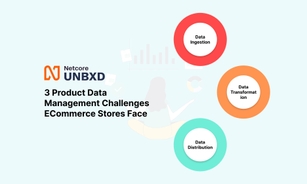- ProductsSearch and BrowseRecommendations
- Solutions
- Integrations


Customer experience and customer experience management are two main factors determining whether a business sinks or swims in the current modern marketplace. For improving customer experience, providing omnichannel customer experience is an essential factor – and doing so is simple.
An omnichannel customer experience is a unified user engagement approach in which a company gives customers access to its products, services, and offers on all channels, platforms, and devices. In simpler terms, the omnichannel experience is where you can check the product at a store and buy it online or order a product online and pick it up at the store. This retail experience is becoming ubiquitous, and companies are developing more seamless engagement strategies to enhance either type of customer experience.
Why do customers want an omnichannel experience?

-
To save time: It can take too much of the customer’s time when you offer service on many channels without integrating them. Hence, optimizing each channel to make them work together is crucial. Offer timely service on all channels by giving the customer a quick, personalized response.
-
To feel comfortable: You must give channel choices to customers, as not every customer will be comfortable with the same channel. Therefore, optimizing every channel is critical to making customers feel comfortable on their preferred channels.
-
Availability of their preferred brand: An omnichannel strategy is essential for your brand when you cannot provide 24×7 service on every channel. Ensure you inform your customers about the operating hours and how they can contact you whenever one channel is unavailable.
-
To communicate with customers exclusively on preferred channels: When you determine a customer’s most preferred channel, you must consider it the best for engaging with them. It’s essential to follow up with the case tasks on the initial contact channel. Customers feel reassured when you take the time to identify their preferences.
-
Seamless in-store experiences: Customers want to connect their digital shopping experiences with their in-store experience. According to a Forrester study, 50% of customers want to purchase online and pick up in-store. Meanwhile, 45% of shoppers expect salespeople to know about online-only products.
What does it take to build an omnichannel experience?

Here are the five essentials that are required to build a modern omnichannel strategy:
1. Data management: For consolidated data
Having consolidated and consistent product information, a single source of truth, and a centralized process for data management are at the heart of effective data management. When you give your customers accurate and consistent product information, you offer an excellent product and customer experience. This also allows customers to move seamlessly from one channel to another throughout their buying journey. Furthermore, when data management is carried out effectively – for example, with the Unbxd PIM tool that centralizes, curates, and syndicates product information – you can enhance omnichannel brand presence.
2. Unified and connected systems: To power omnichannel
Your omnichannel strategy only gives you the best results when your internal systems are well-integrated and connected. To deliver a seamless customer experience (CX), you must deploy APIs to facilitate data transfers and integrate critical applications crucial to your technology landscape. This way, real-time inventory is well-synced between physical/online stores with integrated customer data. It enables optimum omnichannel experience on customer touchpoints, like IoT devices, POS, kiosks, etc.

3. Shared workflows: To access required product information
You must have shared workflows between your shareholders, employees, and third-party dealers to enable them to access requisite information. This information must be stored in a master file and made accessible through API calls to accurately distribute information throughout the retail ecosystem. A robust PIM solution makes distributing relevant product information throughout the retail ecosystem easier. For example, the Unbxd PIM tool enables hassle-free import and export of product data with native API integrations.
4. Detailed product attributes: To let customers make informed purchasing decisions
Customers expect detailed product descriptions with attributes while buying a product. They also feel satisfied throughout the buyer journey when they have explicit videos, images, and product details, which provide greater product visibility. In addition, when your product is assigned attributes, warehousing becomes more accessible, and in-store staff has better product knowledge, which helps them deliver a great buying experience.
5. Segmentation and targeting: To offer customized content
When you have accurate data on buying patterns, purchasing decisions, customer satisfaction, etc., you can derive the correct analysis for understanding and segmenting your customer base. This helps you design personalized and unique content for each segment and targeted customers. According to a survey by MarketingSherpa, more than 20% of customers opt to stop brand communications when they receive irrelevant content. For example, dynamic content on smartphones attracts youngsters, while older audiences look for offer-based mail.
Unbxd PIM has an AI-powered intent-driven search solution for connecting your shoppers to the products they intend to purchase.
Summary
-
Providing omnichannel customer experience is an essential factor for improving customer experience.
-
Omnichannel experience is where you can check the product at a store and buy it online or order a product online and pick it up at the store.
-
Customers want an omnichannel experience to save time, feel comfortable, and have a seamless in-store experience and buy only their preferred brand on the preferred channel.
The five essentials required for a modern omnichannel strategy are data management, connected systems, shared workflows, assigning product attributes, and segmentation.
Book a demo to explore Unbxd PIM

